Improving Route Selections in ZigBee Wireless Sensor Networks
Abstract
1. Introduction
- We studied and compared the performances of the LS-based and LQI-based link cost estimation procedures suggested by the ZigBee specifications. We confirmed the findings of previous studies—that selecting routes based on solely the exchange of link status messages or LQI measurements can lead to poor route selections in ZigBee.
- We proposed and evaluated the performance of a link cost estimation procedure that can be implemented without changes to the ZigBee protocol. As described in Section 6, the method that we propose is founded on estimating the probability of successful transmission by using information from the medium access control (MAC) layer regarding unicast retransmissions. Although the use of MAC layer information to estimate link costs has been considered before in other wireless networks [16,17,18,21,23,24,25,26,27,28], our method has procedures tailored to ZigBee. Furthermore, our procedure defines how to select among routes with the same cumulative costs, which is common in ZigBee links because ZigBee frame formats require the quantization of link costs into three bits. Although our procedure requires changes in the service access point between the network and MAC layers so that the MAC layer supplies more information than anticipated by the ZigBee specifications, the procedure can be implemented without changes to the ZigBee protocol or to the format of its frames. Focusing on a home environment with one or two hops, our simulations indicate that our procedure can offer better performance than either the LS-based or LQI-based procedures in several scenarios.
2. Overview of ZigBee
- The link costs present in the LS message are quantized into three bits (see Section 3.4.8 of [13]).
- ZigBee differentiates between outgoing and incoming link costs; however, for M2O routing, the ZigBee specifications define that path costs be based on the maximum between them (see second paragraph of page 347 of [13]). To simplify our discussion, link costs in this paper refer to the maximum between the incoming and outgoing costs of a link.
2.1. IEEE 802.15.4 MAC and Physical Layers
2.2. Many-To-One Source Routing Algorithm
2.3. Link and Route Costs
3. Estimating Link and Route Costs
3.1. Literature Review
- The authors in [27] proposed the EAR (efficient and accurate link-quality monitor) procedure in which nodes constantly switch between passive, cooperative, and active modes of estimation in order to estimate a metric similar to ETX.
- Focusing on the IPv6 routing protocol for low Power and lossy networks (RPL), the authors in [18] proposed that link qualities be estimated by counting the number of first time transmissions that are unsuccessful and by using an active probing mechanism where nodes send unicast messages to neighbors to estimate the link quality.
3.2. Link Status (LS)-Based Estimation Procedure
3.3. Link Quality Indicator (LQI)-Based Estimation Procedure
4. Simulation Tool to Evaluate Link Cost Estimation Procedures
Parameters Common to All Simulations
5. Motivating Examples
5.1. Example 1: Symmetric Topology
5.2. Example 2: Asymmetric Topology
5.3. Analyzing the LS-Based and LQI-Based Estimation Procedures
- The LS-based procedure produces estimates with higher variance than the LQI-based procedure.
- The LQI-based procedure is blind to hidden node instances.
6. Proposed Link Cost Estimation and Modified Route Selection Procedure
6.1. Link Cost Estimation Procedure
6.2. Modified Route Selection Procedure
6.3. Implementation Considerations
- Nodes need to track the number of packets transmitted and the number of packets acknowledged with each neighbor node separately. This information should be stored within the network layer to enable access by the route selection function. The network layer already has provisions for a neighbor list [13], which could be expanded to store this additional information. Ideally, the time of each transmission would be stored in order to determine when transmission records become older than the averaging window. Results that follow assume this ability. Alternatively, the tracking of the number of packets successfully transmitted could be implemented with a cyclic buffer, where the result of the latest transmission would overwrite the result of the oldest transmission in the buffer.
- The IEEE 802.15.4 MAC layer must be augmented so that it provides the network layer with the number of retransmissions needed to transmit a packet. This would probably be done in the service application point and the MAC would provide this information in additional fields of the MCPS-Data.Confirm message. Although provisioning of such information is not forecasted by the IEEE 802.15.4 MAC specification, it is possible for manufacturers to offer additional information in their service access points while still complying with the IEEE 802.15.4 specification.
- The treatment of the RREQ at the network layer would have to be augmented to follow the procedure of Figure 3b.
7. Performance Evaluation
7.1. Symmetric Topologies
7.1.1. Scenario S1: ZigBee-Only, One-Hop Routes
- The average estimated cost measured at node 3 for the routes 3,1,0 and 3,2,0. For example, for the route 3,2,0:
- The standard deviation of the estimated costs measured at node 3 for the routes 3,1,0 and 3,2,0. For example, for the route 3,2,0:The measures and tell us how much the cost of each route varied over the course of the simulation run.
7.1.2. Scenario S2: WiFi interference
7.1.3. Scenario S3: Two-Hop Scenario
7.2. Asymmetric Topologies
7.2.1. Scenario A1: ZigBee-Only, One-Hop Routes
7.2.2. Scenario A2: WiFi Interference
7.2.3. Scenario A3: Two-Hop Scenario
7.3. Random Topologies
8. Conclusions and Avenues for Future Research
Avenues for Future Research
- Although this paper considered some scenarios involving WiFi interference, further scenarios involving WiFi interference would complement the results presented here. More simulations could also reduce the large variation observed in the scenarios with WiFi interference.
- The U-RR procedure proposed here considers a fixed observation window to estimate the cost of various routes. Since such an estimation depends on the number of unicast packets being transmitted, it would be interesting to study modifications in which the observation window adapts to the amount of unicast traffic generated.
- The U-RR procedure here was designed for the many-to-one routing algorithm of ZigBee. Although the ideas behind the U-RR procedure could also be applied in the other routing algorithms, new simulations and analysis would be necessary to determine whether the U-RR procedure would be useful in other routing algorithms as well.
- In this study, we considered the default parameters of the ZigBee network layer and the IEEE 802.15.4 MAC and physical layers. Given that the performance of these systems can vary with such parameters [29,30], it would be interesting to study whether the results reported here could be improved by optimizing such parameters.
- It would be interesting to study how the proposed route cost estimation procedure could operate together with clustering procedures [54,55,56,57,58]. Clustering procedures build a hierarchical topology in which sensors communicate with clusterheads, which forward the message to other clusterheads that relay the message until it reaches the destination. In the context of this paper, such clusterheads would be selecting routes towards the concentrator by using a route cost estimation procedure, such as the U-RR procedure, and it would be interesting to consider clustering algorithms that select clusterheads while taking into consideration the cost variations in the routes that interconnect them.
Author Contributions
Funding
Acknowledgments
Conflicts of Interest
References
- Farahani, S. ZigBee Wireless Networks and Transceivers; Newnes: Oxford, UK, 2011. [Google Scholar]
- Gislason, D. Zigbee Wireless Networking; Newnes: Oxford, UK, 2008. [Google Scholar]
- IEEE Standards Association. IEEE Standards Association. IEEE Standard for Low-Rate Wireless Networks. In IEEE Std 802.15.4-2015 (Revision of IEEE Std 802.15.4-2011); IEEE: New York, NY, USA, 2016; pp. 1–709. [Google Scholar] [CrossRef]
- Kim, S.H.; Chong, P.K.; Kim, T. Performance study of routing protocols in ZigBee wireless mesh networks. Wirel. Pers. Commun. 2017, 95, 1829–1853. [Google Scholar] [CrossRef]
- Happich, J. Zigbee Alliance Wants More of IoT Market with All Hubs Initiative. 2019. Available online: https://www.eenewseurope.com/news/zigbee-alliance-wants-more-iot-market-all-hubs-initiative (accessed on 28 November 2019).
- Cravotta, N. Keeping Pace with the Evolution of Standards. 2019. Available online: https://www.embedded-computing.com/iot/keeping-pace-with-the-evolution-of-standards (accessed on 28 November 2019).
- Gočal, P.; Macko, D. EEMIP: Energy-Efficient Communication Using Timing Channels and Prioritization in ZigBee. Sensors 2019, 19, 2246. [Google Scholar] [CrossRef] [PubMed]
- Li, P.; Yan, Y.; Yang, P.; Li, X.Y.; Lin, Q. Coexist WiFi for ZigBee Networks With Fine-Grained Frequency Approach. IEEE Access 2019, 7, 135363–135376. [Google Scholar] [CrossRef]
- Gheorghiu, R.; Iordache, V. Use of Energy Efficient Sensor Networks to Enhance Dynamic Data Gathering Systems: A Comparative Study between Bluetooth and ZigBee. Sensors 2018, 18, 1801. [Google Scholar] [CrossRef] [PubMed]
- Li, Y.; Chi, Z.; Liu, X.; Zhu, T. Passive-ZigBee: Enabling ZigBee Communication in IoT Networks with 1000X+ Less Power Consumption. In Proceedings of the 16th ACM Conference on Embedded Networked Sensor Systems, Shenzhen, China, 4–7 November 2018; pp. 159–171. [Google Scholar]
- Vaquerizo-Hdez, D.; Muñoz, P.; F Barrero, D. A low power consumption algorithm for efficient energy consumption in zigbee motes. Sensors 2017, 17, 2179. [Google Scholar] [CrossRef]
- Leão, E.; Montez, C.; Moraes, R.; Portugal, P.; Vasques, F. Alternative Path Communication in Wide-Scale Cluster-Tree Wireless Sensor Networks Using Inactive Periods. Sensors 2017, 17, 1049. [Google Scholar] [CrossRef]
- ZigBee Alliance, Inc. ZigBee Specification; ZigBee Alliance, Inc.: Davis, CA, USA, 2015. [Google Scholar]
- Feng, Y.; Liu, L.; Shu, J. A Link Quality Prediction Method for Wireless Sensor Networks Based on XGBoost. IEEE Access 2019, 7, 155229–155241. [Google Scholar] [CrossRef]
- Ancillotti, E.; Vallati, C.; Bruno, R.; Mingozzi, E. A reinforcement learning-based link quality estimation strategy for RPL and its impact on topology management. Comput. Commun. 2017, 112, 1–13. [Google Scholar] [CrossRef]
- Panousopoulou, A.; Azkune, M.; Tsakalides, P. Feature selection for performance characterization in multi-hop wireless sensor networks. Ad Hoc Netw. 2016, 49, 70–89. [Google Scholar] [CrossRef]
- Liu, T.; Cerpa, A.E. Data-driven link quality prediction using link features. ACM Trans. Sens. Netw. (TOSN) 2014, 10, 37. [Google Scholar] [CrossRef]
- Ancillotti, E.; Bruno, R.; Conti, M. Reliable Data Delivery with the IETF Routing Protocol for Low-Power and Lossy Networks. IEEE Trans. Ind. Inform. 2014, 10, 1864–1877. [Google Scholar] [CrossRef]
- Di Caro, G.A.; Kudelski, M.; Flushing, E.F.; Nagi, J.; Ahmed, I.; Gambardella, L.M. Online supervised incremental learning of link quality estimates in wireless networks. In Proceedings of the 2013 12th Annual Mediterranean Ad Hoc Networking Workshop (MED-HOC-NET), Ajaccio, France, 24–26 June 2013; pp. 133–140. [Google Scholar]
- Zhang, H.; Sang, L.; Arora, A. Comparison of data-driven link estimation methods in low-power wireless networks. IEEE Trans. Mob. Comput. 2010, 9, 1634–1648. [Google Scholar] [CrossRef]
- Kim, K.H.; Shin, K.G. On accurate and asymmetry-aware measurement of link quality in wireless mesh networks. IEEE/ACM Trans. Netw. (TON) 2009, 17, 1172–1185. [Google Scholar]
- Zhang, H.; Arora, A.; Sinha, P. Link estimation and routing in sensor network backbones: Beacon-based or data-driven? IEEE Trans. Mob. Comput. 2008, 8, 653–667. [Google Scholar] [CrossRef]
- Woo, A.; Tong, T.; Culler, D. Taming the underlying challenges of reliable multihop routing in sensor networks. In Proceedings of the 1st International Conference on Embedded Networked Sensor Systems, Los Angeles, CA, USA, 5–7 November 2003; pp. 14–27. [Google Scholar]
- He, T.; Stankovic, J.A.; Lu, C.; Abdelzaher, T. SPEED: A stateless protocol for real-time communication in sensor networks. In Proceedings of the 23th IEEE International Conference on Distributed Computing Systems, Providence, RI, USA, 19–22 May 2003. [Google Scholar]
- Krishnan, R.; Raniwala, A.; Chiueh, T.C. Design of a channel characteristics-aware routing protocol. In Proceedings of the IEEE INFOCOM 2008—The 27th Conference on Computer Communications, Phoenix, AZ, USA, 13–18 April 2008; pp. 2441–2449. [Google Scholar]
- Fonseca, R.; Gnawali, O.; Jamieson, K.; Levis, P. Four-bit wireless link estimation. In Proceedings of the Sixth Workshop on Hot Topics in Networks (HotNets-VI), Atlanta, Georgia, 14–15 November 2007. [Google Scholar]
- Kim, K.H.; Shin, K.G. On accurate measurement of link quality in multi-hop wireless mesh networks. In Proceedings of the 12th Annual International Conference on Mobile Computing and Networking, Bretton Woods, NH, USA, 16–19 June 2006; pp. 38–49. [Google Scholar]
- De Couto, D.S.; Aguayo, D.; Bicket, J.; Morris, R. A high-throughput path metric for multi-hop wireless routing. Wirel. Netw. 2005, 11, 419–434. [Google Scholar] [CrossRef]
- Moravejosharieh, A.; Lloret, J. A survey of IEEE 802.15.4 effective system parameters for wireless body sensor networks. Int. J. Commun. Syst. 2016, 29, 1269–1292. [Google Scholar] [CrossRef]
- Moravejosharieh, A.; Lloret, J. Performance evaluation of co-located IEEE 802.15.4-based wireless body sensor networks. Ann. Telecommun. 2016, 71, 425–440. [Google Scholar] [CrossRef]
- Ahmadi, H.; Krishna, A.; LaMaire, R.O. Design issues in wireless LANs. J. High Speed Netw. 1996, 5, 87–104. [Google Scholar] [CrossRef]
- Tobagi, F.; Kleinrock, L. Packet Switching in Radio Channels: Part II—The Hidden Terminal Problem in Carrier Sense Multiple-Access and the Busy-Tone Solution. IEEE Trans. Commun. 1975, 23, 1417–1433. [Google Scholar] [CrossRef]
- Baccour, N.; Koubâa, A.; Mottola, L.; Zúñiga, M.A.; Youssef, H.; Boano, C.A.; Alves, M. Radio link quality estimation in wireless sensor networks: A survey. ACM Trans. Sens. Netw. (TOSN) 2012, 8, 34. [Google Scholar] [CrossRef]
- Ngangue Ndih, E.D.; Cherkaoui, S. On Enhancing Technology Coexistence in the IoT Era: ZigBee and 802.11 Case. IEEE Access 2016, 4, 1835–1844. [Google Scholar] [CrossRef]
- Ju, X.; Liu, W.; Zhang, C.; Liu, A.; Wang, T.; Xiong, N.; Cai, Z. An energy conserving and transmission radius adaptive scheme to optimize performance of energy harvesting sensor networks. Sensors 2018, 18, 2885. [Google Scholar] [CrossRef] [PubMed]
- Lu, T.; Liu, G.; Chang, S. Energy-efficient data sensing and routing in unreliable energy-harvesting wireless sensor network. Wirel. Netw. 2018, 24, 611–625. [Google Scholar] [CrossRef]
- Wang, Y.; Zhang, Y.; Zhu, L.; Ji, W.; Liu, Y.; Hei, X. A novel energy-aware trustworthy multi-hop routing model for Internet of things. Int. J. Distrib. Sens. Netw. 2018, 14, 1550147718818689. [Google Scholar] [CrossRef]
- Ren, J.; Zhang, Y.; Zhang, K.; Liu, A.; Chen, J.; Shen, X.S. Lifetime and energy hole evolution analysis in data-gathering wireless sensor networks. IEEE Trans. Ind. Inform. 2015, 12, 788–800. [Google Scholar] [CrossRef]
- Rault, T.; Bouabdallah, A.; Challal, Y. Energy efficiency in wireless sensor networks: A top-down survey. Comput. Netw. 2014, 67, 104–122. [Google Scholar] [CrossRef]
- Liu, A.; Ren, J.; Li, X.; Chen, Z.; Shen, X.S. Design principles and improvement of cost function based energy aware routing algorithms for wireless sensor networks. Comput. Netw. 2012, 56, 1951–1967. [Google Scholar] [CrossRef]
- Kandris, D.; Tsioumas, P.; Tzes, A.; Nikolakopoulos, G.; Vergados, D. Power conservation through energy efficient routing in wireless sensor networks. Sensors 2009, 9, 7320–7342. [Google Scholar] [CrossRef]
- Vergados, D.J.; Pantazis, N.A.; Vergados, D.D. Energy-efficient route selection strategies for wireless sensor networks. Mob. Netw. Appl. 2008, 13, 285–296. [Google Scholar] [CrossRef]
- Chang, J.H.; Tassiulas, L. Maximum lifetime routing in wireless sensor networks. IEEE/ACM Trans. Netw. 2004, 12, 609–619. [Google Scholar] [CrossRef]
- Gupta, A.; Sharma, M.; Marot, M.; Becker, M. Hybridlqi: Hybrid multihoplqi for improving asymmetric links in wireless sensor networks. In Proceedings of the 2010 Sixth Advanced International Conference on Telecommunications, Barcelona, Spain, 9–15 May 2010; pp. 298–305. [Google Scholar]
- Polastre, J.; Szewczyk, R.; Culler, D. Telos: Enabling ultra-low power wireless research. In Proceedings of the 4th International Symposium on Information Processing in Sensor Networks, Los Angeles, CA, USA, 24–27 April 2005; p. 48. [Google Scholar]
- Gungor, V.C.; Sastry, C.; Song, Z.; Integlia, R. Resource-aware and link quality based routing metric for wireless sensor and actor networks. In Proceedings of the 2007 IEEE International Conference on Communications, Glasgow, UK, 24–28 June 2007; pp. 3364–3369. [Google Scholar]
- Sun, W.; Lu, W.; Li, Q.; Chen, L.; Mu, D.; Yuan, X. WNN-LQE: Wavelet-neural-network-based link quality estimation for smart grid WSNs. IEEE Access 2017, 5, 12788–12797. [Google Scholar] [CrossRef]
- Bote-Lorenzo, M.L.; Gómez-Sánchez, E.; Mediavilla-Pastor, C.; Asensio-Pérez, J.I. Online machine learning algorithms to predict link quality in community wireless mesh networks. Comput. Networks 2018, 132, 68–80. [Google Scholar] [CrossRef]
- Mostafaei, H. Energy-Efficient Algorithm for Reliable Routing of Wireless Sensor Networks. IEEE Trans. Ind. Electron. 2019, 66, 5567–5575. [Google Scholar] [CrossRef]
- Riley, G.F.; Henderson, T.R. The ns-3 network simulator. In Modeling and Tools for Network Simulation; Springer: Cham, Switzerland, 2010; pp. 15–34. [Google Scholar]
- ns-3: A Discrete-Event Network Simulator for Internet Systems. 2019. Available online: https://www.nsnam.org (accessed on 1 December 2019).
- ns-3: Low-Rate Wireless Personal Area Network (LR-WPAN). 2019. Available online: https://www.nsnam.org/docs/models/html/lr-wpan.html (accessed on 1 December 2019).
- Graybill, F.A.; Deal, R. Combining unbiased estimators. Biometrics 1959, 15, 543–550. [Google Scholar] [CrossRef]
- Liu, X. A survey on clustering routing protocols in wireless sensor networks. Sensors 2012, 12, 11113–11153. [Google Scholar] [CrossRef] [PubMed]
- Xu, L.; Collier, R.; O’Hare, G.M. A survey of clustering techniques in WSNs and consideration of the challenges of applying such to 5G IoT scenarios. IEEE Internet Things J. 2017, 4, 1229–1249. [Google Scholar] [CrossRef]
- Sandeep, D.N.; Kumar, V. Review on Clustering, Coverage and Connectivity in Underwater Wireless Sensor Networks: A Communication Techniques Perspective. IEEE Access 2017, 5, 11176–11199. [Google Scholar] [CrossRef]
- Zafar, S.; Bashir, A.; Chaudhry, S.A. Mobility-Aware Hierarchical Clustering in Mobile Wireless Sensor Networks. IEEE Access 2019, 7, 20394–20403. [Google Scholar] [CrossRef]
- Naranjo, P.G.V.; Shojafar, M.; Mostafaei, H.; Pooranian, Z.; Baccarelli, E. P-SEP: A prolong stable election routing algorithm for energy-limited heterogeneous fog-supported wireless sensor networks. J. Supercomput. 2017, 73, 733–755. [Google Scholar] [CrossRef]




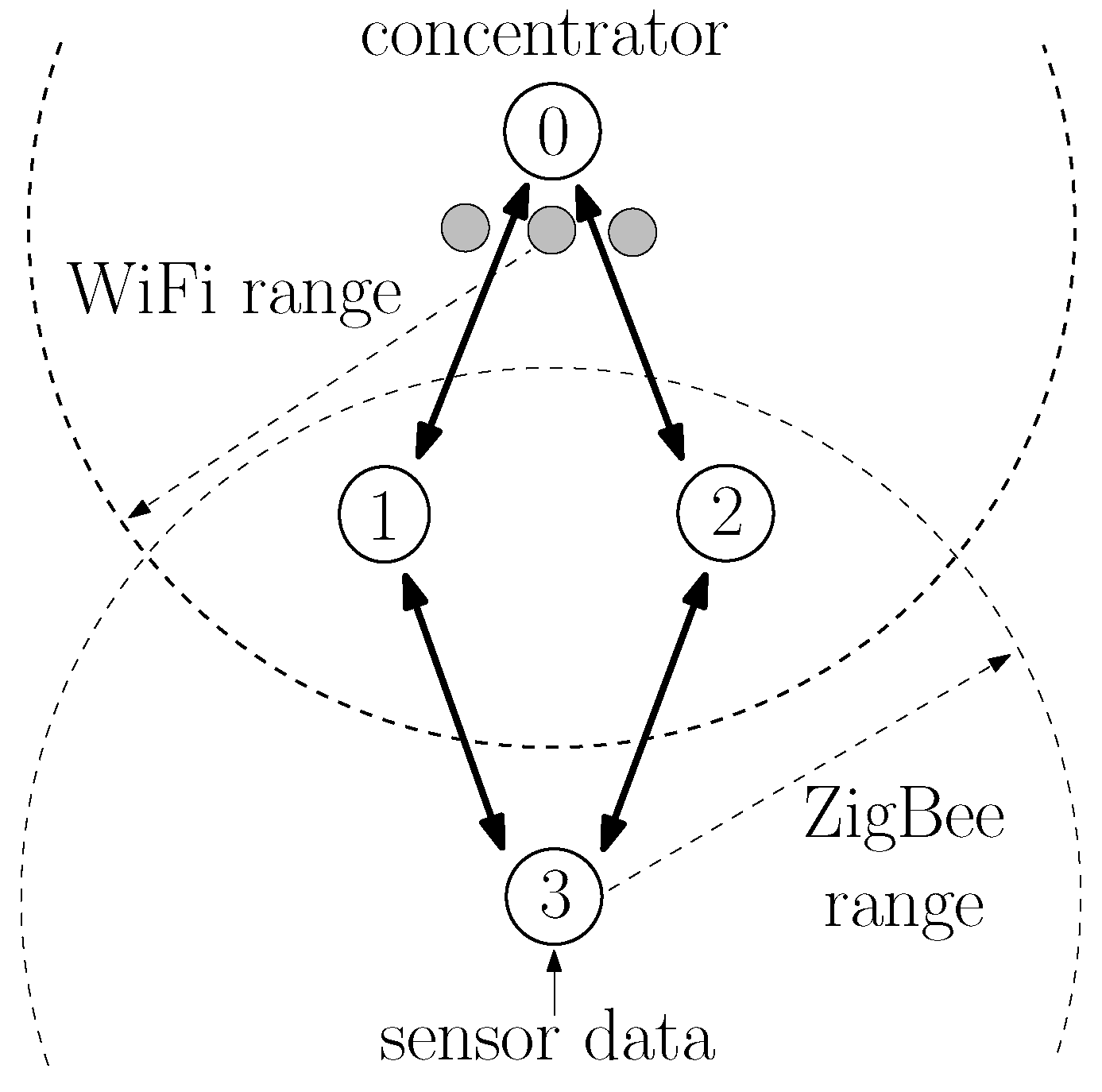

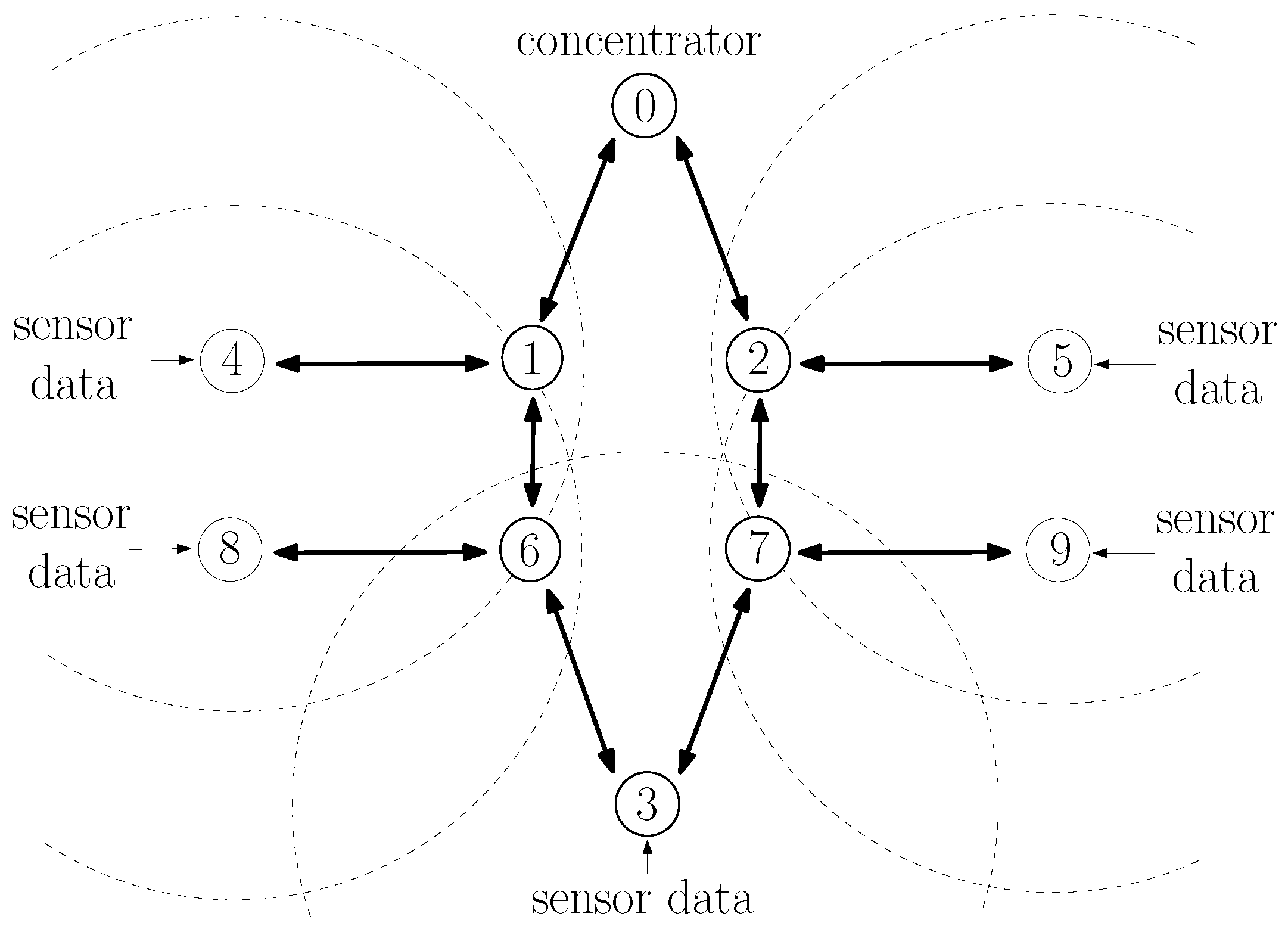
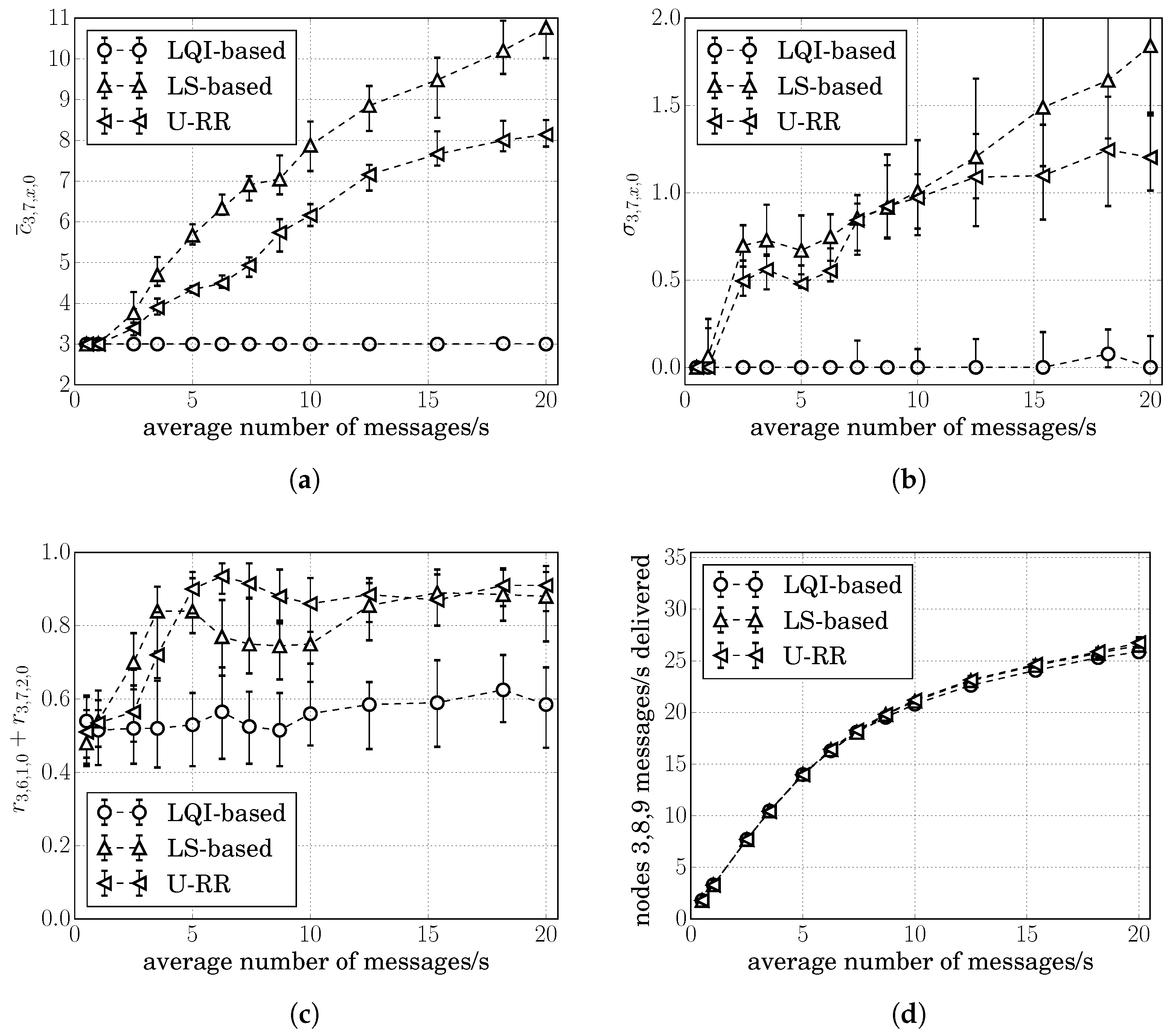
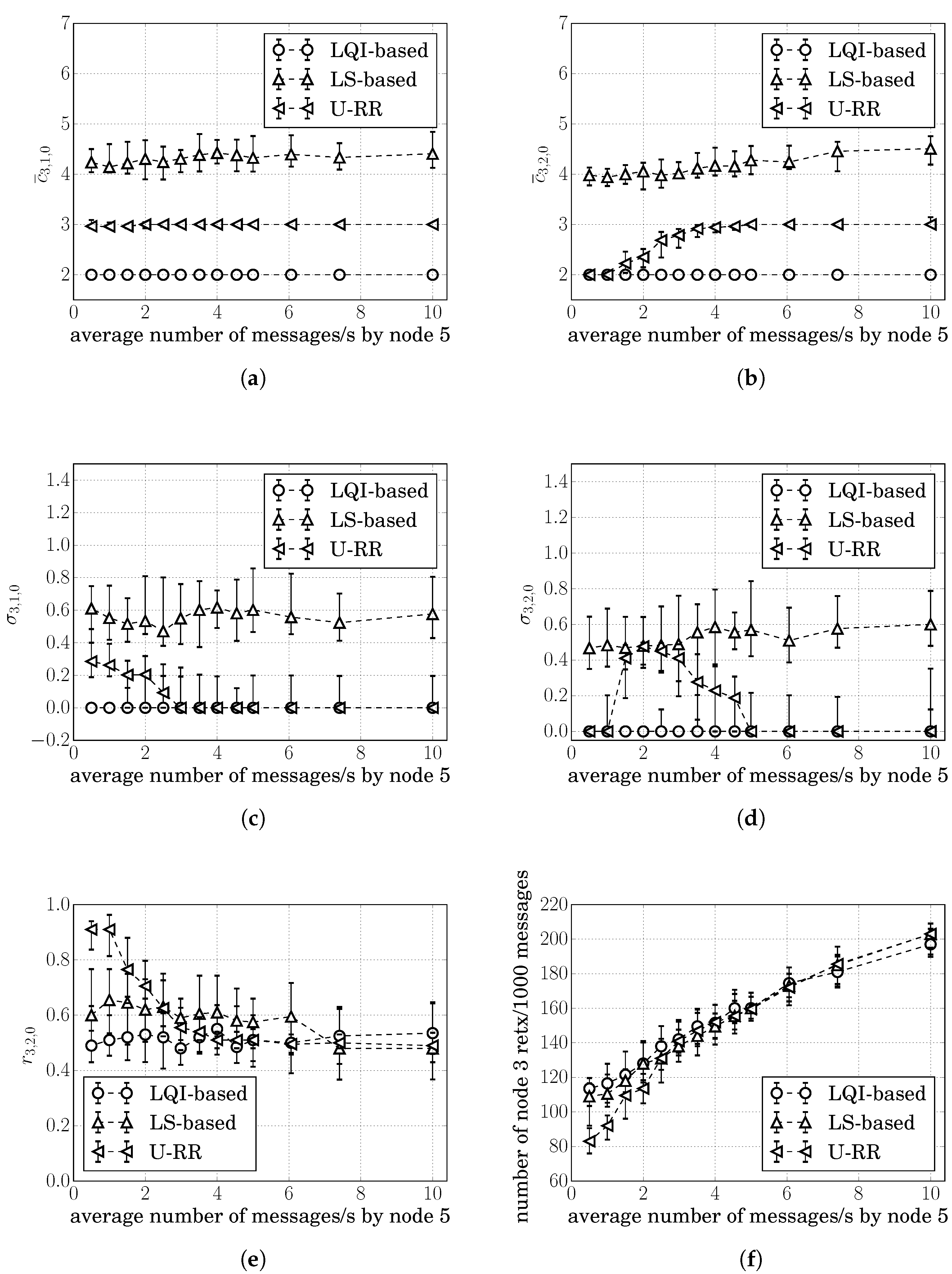





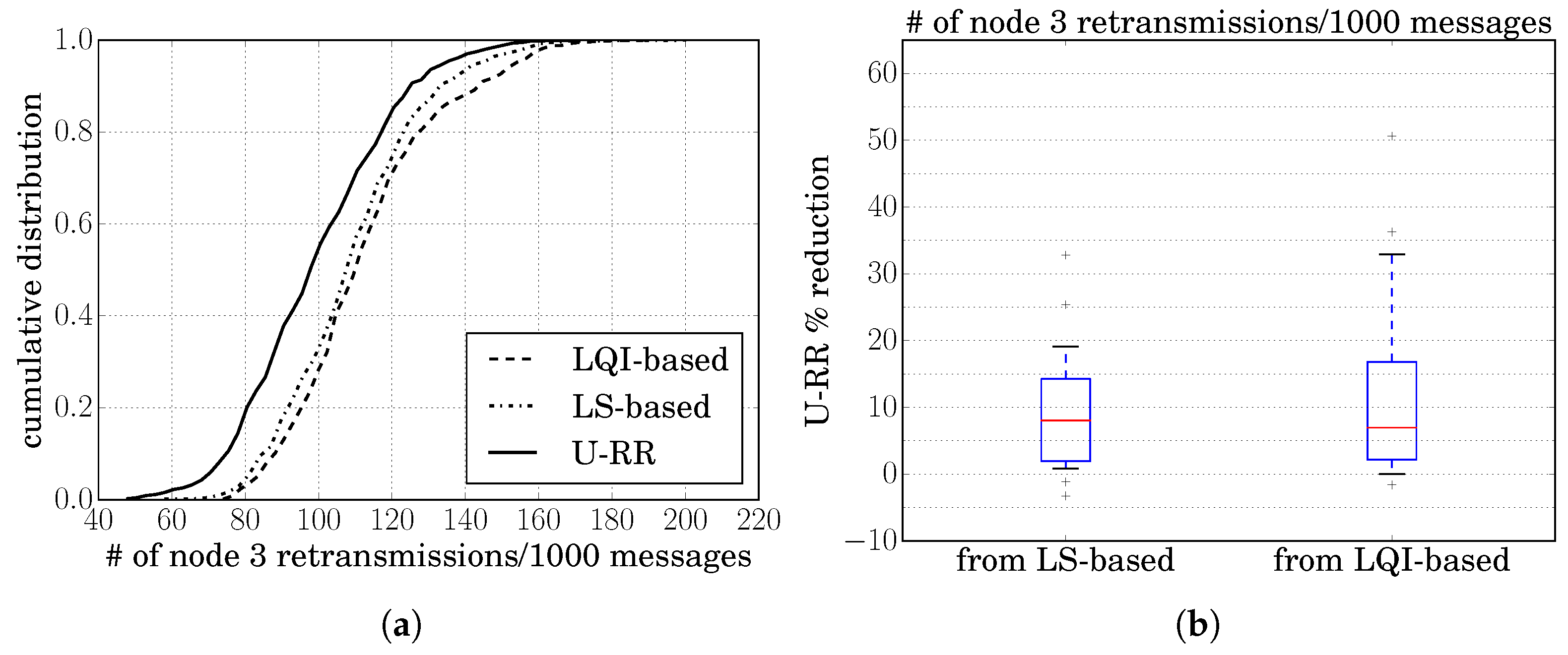
| Average LQI Interval | Average LQI Interval | Average LQI Interval | |||
|---|---|---|---|---|---|
| 1 | 4 | 7 | |||
| 2 | 5 | ||||
| 3 | 6 |
| 1 | 1.000 | 3 | 0.795 | 5 | 0.686 | 7 | 0.626 |
| 2 | 0.903 | 4 | 0.731 | 6 | 0.652 |
© 2019 by the authors. Licensee MDPI, Basel, Switzerland. This article is an open access article distributed under the terms and conditions of the Creative Commons Attribution (CC BY) license (http://creativecommons.org/licenses/by/4.0/).
Share and Cite
Meka, S.; Fonseca, B., Jr. Improving Route Selections in ZigBee Wireless Sensor Networks. Sensors 2020, 20, 164. https://doi.org/10.3390/s20010164
Meka S, Fonseca B Jr. Improving Route Selections in ZigBee Wireless Sensor Networks. Sensors. 2020; 20(1):164. https://doi.org/10.3390/s20010164
Chicago/Turabian StyleMeka, Srikar, and Benedito Fonseca, Jr. 2020. "Improving Route Selections in ZigBee Wireless Sensor Networks" Sensors 20, no. 1: 164. https://doi.org/10.3390/s20010164
APA StyleMeka, S., & Fonseca, B., Jr. (2020). Improving Route Selections in ZigBee Wireless Sensor Networks. Sensors, 20(1), 164. https://doi.org/10.3390/s20010164





